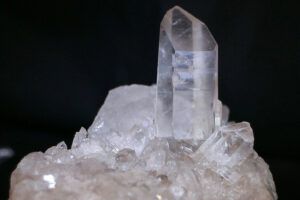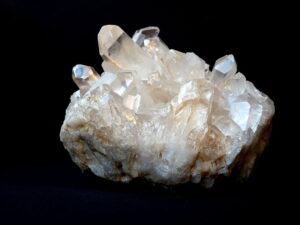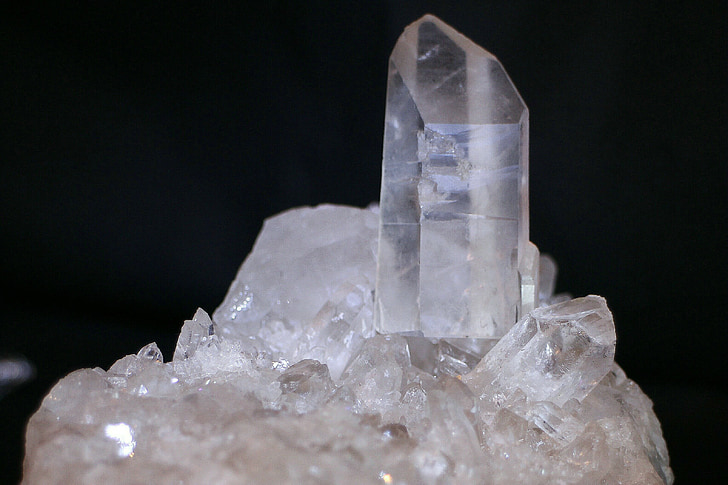Healing Attributes of Quartz
Quartz, a remarkable crystal, boasts an array of profound healing qualities. Often referred to as the “master healer,” it possesses formidable capabilities and stands as one of the most versatile crystals in existence.
Quartz excels in absorbing and harmonizing energies, amplifying the potency of other stones it interacts with.
This crystal can be harnessed to restore equilibrium within all seven chakras, enhance psychic aptitude, and sharpen memory and concentration. It proves invaluable in quelling the ceaseless chatter of thoughts that often besiege our minds.
Clear quartz, in particular, promotes inner serenity and lucidity. It acts as a soothing balm, alleviating stress, worries, and anxieties, ushering you into a profound state of relaxation and tranquility. Consequently, it finds a fitting companion in meditation practices.
Quartz’s therapeutic attributes extend to heightening intuition and fostering insightful thinking, facilitating clear, informed decision-making.
With quartz comes a surge of strength and positivity, propelling you toward greater achievements in life. A buoyant state of mind holds the power to influence others, chiefly through your choices and actions.
Quartz cultivates emotional resilience and imparts the finesse to gracefully navigate challenges. It bolsters emotional intelligence, fostering awareness for nurturing authentic, positive relationships.
It serves as a guide for appreciating the present moment and finding contentment in life’s simple joys.
Harnessing the finely tuned energies of quartz enhances holistic well-being. Striking a harmonious balance between mental and physical health paves the way for a purposeful, gratifying, and joyful existence.
It’s important to note that the healing properties of quartz are deeply personal and subjective. Individuals may experience varied benefits influenced by their unique beliefs, life experiences, and intentions. Different varieties of quartz can be employed for healing purposes in diverse ways, catering to individual needs and preferences.

What is Quartz?
Quartz is the most common mineral in Earth’s crust after ice and feldspar. It can be found in almost every geological environment and is a component of virtually every rock type. It has exceptional durability and is the main constituent in all types of sand.
Quartz is the world’s most diverse mineral in terms of varieties, colours and forms because of its abundance and widespread distribution. It can be found in sedimentary rocks as grains of sand and as crystals in igneous and metamorphic rocks.
Quartzite which is composed almost completely of the mineral quartz is produced through the metamorphism of sandstone.
Silicon dioxide is a chemical compound of two of the most abundant elements in Earth’s crust, silicon and oxygen. Found most commonly in nature as the mineral quartz, it exists in several crystalline forms and a number of cryptocrystalline forms.
Silicon dioxide is also known as silica.
The name “quartz” is believed to come from the old German word “quarz” which first appeared in 1530. In ancient Greece it was known as “krustallos” from “kruos” meaning “icy cold”. This may be because of the clarity of some quartz crystals.
Theophrastus ancient Greek philosopher and successor to Aristotle believed colourless quartz crystals were a unique type of ice that wouldn’t melt.
What Does Quartz Do?
Quartz crystals possess a unique property called piezoelectricity. This means they generate an electric charge when exposed to mechanical stress or pressure.
Crystals vibrate at exceptionally precise intervals when an electric current is applied. This could be likened to a metronome that’s ticking repeatedly at a steady pace.
The piezoelectricity produced by a quartz crystal enables an electronic circuit to generate regular accurate signals. These are essential for measuring time.
The frequency at which a quartz crystal vibrates is determined by its shape, size, thickness and how it’s cut. The frequency can be adjusted by altering any one of these properties.
Quartz crystals used in timekeeping devices vibrate at precisely 32,768 times per second.
Quartz was the first crystal to be used in a radio transmission and was fundamental to the development of computers.

Rock Crystal Clear Colourless Quartz
Rock crystal is an alternative name for the purest type of quartz. In its purest form quartz is colourless and transparent hence the term “crystal clear”.
The presence of impurities causes a wide variety of colours from milky white to dark brown verging on black.
Many different varieties of quartz exist. It occurs in two forms, crystalline and cryptocrystalline which means crystals are too small to be seen with the naked eye.
Coloured varieties of quartz tend to be translucent as opposed to transparent and most have their own unique name. Inclusions in quartz are relatively common.
Material with inclusions is often referred to as included quartz. Rutile and tourmaline are two of the most common mineral inclusions.
The optical properties of quartz led to its extensive use in lenses and prisms. It was once widely used in electronic components but has now been replaced with a synthetic alternative.
As well as its electrical properties quartz is also resistant to heat. Being graded 7 on Mohs scale of mineral hardness makes it harder than many other natural minerals. It’s therefore often used as an abrasive.
Despite its hardness quartz is brittle so will break or shatter easily. Hardness and toughness are different characteristics. Hardness refers to a mineral’s resistance to being scratched by another. Toughness correctly known as tenacity refers to its resistance to being bent, cracked, chipped or broken.
Different Types of Quartz
Agate
Translucent variety of chalcedony known for its distinctive banding
Amethyst
Purple variety of quartz whose colour is caused primarily by iron but also manganese
Aventurine
Type of translucent quartz usually identified by its platy inclusions
Bloodstone
Dark green chalcedony, often features red markings from inclusions of hematite
Carnelian
Reddish to rich orange coloured quartz. Translucent variety of chalcedony. Sometimes referred to as cornelian
Chalcedony
Variety of microcrystalline quartz, white in its purest form. Most types of chalcedony have their own unique name such as agate, bloodstone or carnelian
Chevron Amethyst
Combination of colourless or milky white quartz combined with amethyst. Named for its chevron-like markings. Tends to be known as banded amethyst in the UK
Chrysoprase
Translucent apple green variety of chalcedony. The colour comes from nickel
Citrine
Yellow to yellowish brown coloured quartz that’s fairly rare. Most commercial grade citrine is heated amethyst
Included Quartz
Inclusions are common in quartz and although some varieties have their own name, most are known as included quartz
Jasper
Cryptocrystalline variety of chalcedony. Features fine inclusions of varying amounts of other minerals and substances. These cause the stone to be opaque and are responsible for its colour
Milky Quartz
White to greyish-white translucent to opaque variety. Often occurs in the same deposit as rock crystal
Onyx
Striped variety of agate with alternating black and white bands. The name is widely used incorrectly
Rose Quartz
Pink coloured stone usually translucent. Crystal habit is massive. Pink quartz which is considered to be a different variety is often confused for rose quartz. The main difference is crystals are quite common whereas in rose quartz individual crystals have never been found
Rock Crystal
Colourless and transparent. The name came about during the late Middle Ages in order to differentiate this type of quartz from a newly produced colourless material known as glass. Glass was known as crystal or crystal glass

Sard
Translucent light to dark brown coloured chalcedony. Until the Middle Ages sard shared its name with carnelian. Gemstones with bands of white sard and chalcedony are called are called sardonyx
Smoky Quartz
Translucent to transparent mineral that occurs in various shades of brown. Colour can vary from light to so dark it almost appears to be black. Sometimes incorrectly referred to as smoky topaz which is a different mineralRoyalty-Free photo: rock crystal, crystal, crystal quartz, quartz, pure quartz, mineral, transparent, clear, ref
Tigers Eye
Type of quartz with a rich golden yellow colour caused by the presence of iron. Also known as tiger eye

